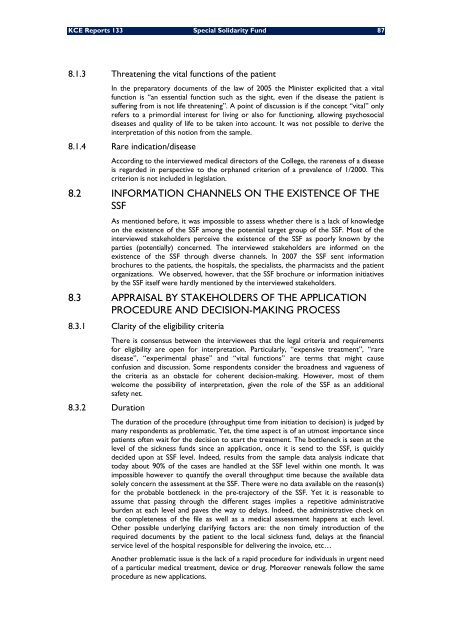Optimalisatie van de werkingsprocessen van het Bijzonder ... - KCE
Optimalisatie van de werkingsprocessen van het Bijzonder ... - KCE
Optimalisatie van de werkingsprocessen van het Bijzonder ... - KCE
You also want an ePaper? Increase the reach of your titles
YUMPU automatically turns print PDFs into web optimized ePapers that Google loves.
<strong>KCE</strong> Reports 133 Special Solidarity Fund 87<br />
8.1.3 Threatening the vital functions of the patient<br />
In the preparatory documents of the law of 2005 the Minister explicited that a vital<br />
function is “an essential function such as the sight, even if the disease the patient is<br />
suffering from is not life threatening”. A point of discussion is if the concept “vital” only<br />
refers to a primordial interest for living or also for functioning, allowing psychosocial<br />
diseases and quality of life to be taken into account. It was not possible to <strong>de</strong>rive the<br />
interpretation of this notion from the sample.<br />
8.1.4 Rare indication/disease<br />
According to the interviewed medical directors of the College, the rareness of a disease<br />
is regar<strong>de</strong>d in perspective to the orphaned criterion of a prevalence of 1/2000. This<br />
criterion is not inclu<strong>de</strong>d in legislation.<br />
8.2 INFORMATION CHANNELS ON THE EXISTENCE OF THE<br />
SSF<br />
As mentioned before, it was impossible to assess w<strong>het</strong>her there is a lack of knowledge<br />
on the existence of the SSF among the potential target group of the SSF. Most of the<br />
interviewed stakehol<strong>de</strong>rs perceive the existence of the SSF as poorly known by the<br />
parties (potentially) concerned. The interviewed stakehol<strong>de</strong>rs are informed on the<br />
existence of the SSF through diverse channels. In 2007 the SSF sent information<br />
brochures to the patients, the hospitals, the specialists, the pharmacists and the patient<br />
organizations. We observed, however, that the SSF brochure or information initiatives<br />
by the SSF itself were hardly mentioned by the interviewed stakehol<strong>de</strong>rs.<br />
8.3 APPRAISAL BY STAKEHOLDERS OF THE APPLICATION<br />
PROCEDURE AND DECISION-MAKING PROCESS<br />
8.3.1 Clarity of the eligibility criteria<br />
There is consensus between the interviewees that the legal criteria and requirements<br />
for eligibility are open for interpretation. Particularly, “expensive treatment”, “rare<br />
disease”, “experimental phase” and “vital functions” are terms that might cause<br />
confusion and discussion. Some respon<strong>de</strong>nts consi<strong>de</strong>r the broadness and vagueness of<br />
the criteria as an obstacle for coherent <strong>de</strong>cision-making. However, most of them<br />
welcome the possibility of interpretation, given the role of the SSF as an additional<br />
safety net.<br />
8.3.2 Duration<br />
The duration of the procedure (throughput time from initiation to <strong>de</strong>cision) is judged by<br />
many respon<strong>de</strong>nts as problematic. Yet, the time aspect is of an utmost importance since<br />
patients often wait for the <strong>de</strong>cision to start the treatment. The bottleneck is seen at the<br />
level of the sickness funds since an application, once it is send to the SSF, is quickly<br />
<strong>de</strong>ci<strong>de</strong>d upon at SSF level. In<strong>de</strong>ed, results from the sample data analysis indicate that<br />
today about 90% of the cases are handled at the SSF level within one month. It was<br />
impossible however to quantify the overall throughput time because the available data<br />
solely concern the assessment at the SSF. There were no data available on the reason(s)<br />
for the probable bottleneck in the pre-trajectory of the SSF. Yet it is reasonable to<br />
assume that passing through the different stages implies a repetitive administrative<br />
bur<strong>de</strong>n at each level and paves the way to <strong>de</strong>lays. In<strong>de</strong>ed, the administrative check on<br />
the completeness of the file as well as a medical assessment happens at each level.<br />
Other possible un<strong>de</strong>rlying clarifying factors are: the non timely introduction of the<br />
required documents by the patient to the local sickness fund, <strong>de</strong>lays at the financial<br />
service level of the hospital responsible for <strong>de</strong>livering the invoice, etc…<br />
Another problematic issue is the lack of a rapid procedure for individuals in urgent need<br />
of a particular medical treatment, <strong>de</strong>vice or drug. Moreover renewals follow the same<br />
procedure as new applications.

















